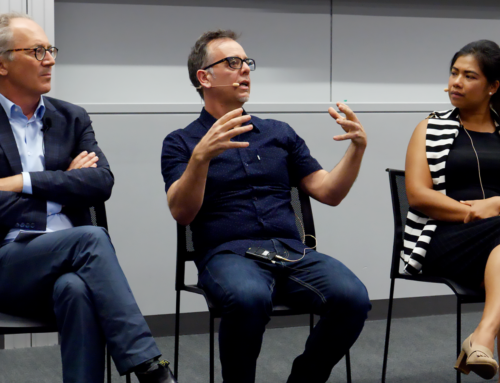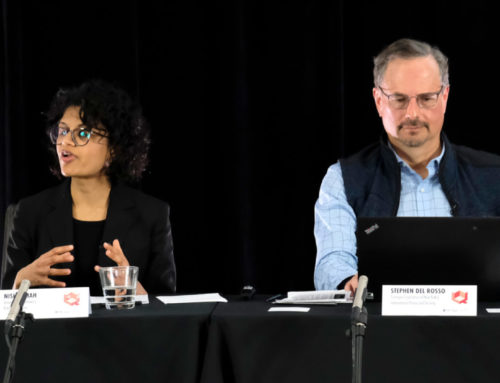The fourth annual Project Q symposium (Q4), held 15-17 February, brought together international scholars to assess the societal and strategic impact of quantum innovation. Any cross-disciplinary gathering faces a broad range of challenges, from finding a common vernacular to negotiating differing standards of ‘expertise’. Capturing both the thematic complexity as well as the intellectual generosity of the event, Professor Steve Fuller, Auguste Comte Chair in Social Epistemology at the University of Warwick, considers in this new Q posting one of the most controversial topics raised at Q4, the matter of quantum consciousness and scientific discovery.

QUANTUM ACROSS THE DISCIPLINES: OBSERVATIONS ON THE 2018 PROJECT Q SYMPOSIUM
Steve Fuller, University of Warwick
I had the privilege this year – courtesy of James Der Derian and Colin Wight — to participate in this year’s Q symposium, QC3I, in Sydney. This event brought together natural and social scientists interested in the implications of the emerging innovations related to quantum mechanics that are transdisciplinary import.
My observations are informed as someone who has recently written a searching but positive review of Alexander Wendt’s Quantum Mind and Social Science, which articulates an ambitious research programme that uses various aspects of quantum mechanics to model the socio-political world. Although the book was published only a couple of years ago, it has already proved very controversial among both natural and social scientists, which was evident from the start of the Q symposium, which featured a public ‘Q Forum’ event at the University of Sydney. The session began with a short film on Project Q, which included a soundbite from Wendt saying, ‘We are walking wave functions’ — to much audible laughter from the audience.
During the Q symposium itself, there was clear pushback to the very idea of Wendt’s programme, but it was nothing like the sorts of cross-disciplinary skirmishes that took place during the height of the Science Wars in the 1990s, when some of the ‘science warriors’ were calling for the sacking of humanists and social scientists for committing crimes against the intellect. An intervention by Der Derian reminded me of this when he sought reassurance that even if Wendt’s project is misguided, he wouldn’t be imprisoned by the scientific thought police. Such threats had been routine back then.
But generally speaking, the scientists at the Q symposium were sufficiently liberal to insist only on exerting a veto power over how social scientists interpreted or drew on their work when they got the science ‘wrong’ in some obvious sense. However, I do think that the cross-disciplinary communication remains less than ideal. And here it is interesting to observe how the scientists understand the history of science. I was especially struck by how clear it was to many of them that certain theories – such as quantum biology and quantum consciousness – have been already refuted, when I would say they are works in progress that admittedly face formidable evidential challenges. However, comparable challenges have been met in the past, which should lead one to be cautious not to take ‘empirically improbable’ as a proxy for ‘logically impossible’.
A more general point is that progress in science does not necessarily require a close tracking of the available evidence. Scientists forget that Galileo looks like a trailblazer only in retrospect – Newton basically redeemed him. In his own day, Galileo’s telescope was treated as a gimmick because he couldn’t explain its optics, his alleged experimental findings were too good to be true, etc. However, Galileo was a master of rhetoric who could conjure up in words what he lacked in technique and results. So while Galileo’s Inquisitors saw through him, the trial attracted sufficient notoriety to inspire others to follow up on his radical ideas. It was this history that led Paul Feyerabend to dismiss the idea that scientific inquiry must be led by some evidence-driven ‘method’.
One way to think about all this is that theorizing in science is really about establishing a credit line that may require some empirical down payment, which could be quite small, but then you use the credit line to recruit others who enable you to repay the original debt by producing the results you need. In this respect, Galileo is comparable to an entrepreneur in Schumpeter’s classic portrayal as the heroic speculator. (I’ve always thought about crowdsourcing as a downstream, democratised, digitised version of speculation.) Maybe this is the best way to evaluate Wendt’s project: namely, the proof will be in who is attracted to redeem it. Seen through the political economy lens, the preoccupation with ‘sticking to the evidence’ is a bit like the rentiers who make it difficult for land (read: concepts) to be productive by charging high rents and tolls for potential users. They may claim to be protecting the land (hence the ‘gatekeeping’ metaphor for peer review) but in the first instance they are exerting monopoly privilege, which has its own not so positive associations.
In the case of quantum mechanics, it is striking the difference in attitude between the founding theorists of the field (who did entertain ‘New Age’ metaphysical views about quantum reality) and latter-day researchers, many of whom are concerned with practical applications, which don’t depend on any of the more extravagant metaphysical views.
But this leaves open the question of how humanists and social scientists should appropriate quantum mechanics. Here a distinction can be made between the mathematical formalism of quantum mechanics, which has been the source of great intrigue and speculation, and the quantum level of reality for which the formalism was originally designed. One charitable way to read the scientists who are sceptical of our appropriations is that they conflate these two aspects of quantum mechanics. However, as Peter Bruza showed in his talk, it is possible to provide evidence for ‘quantum decision making’, in the sense of phenomena that conform to quantum formalism, without presuming the existence of quantum-level activity in the brain. Of course, his research begs the question of what exactly is responsible for the phenomena he’s observed. A Penrose-style story of nanotubules may – but need not – do the job.
I would have thought that this a pretty good way to split the difference between the natural scientists and the social scientists interesting in appropriating quantum mechanics for their own ends. However, it would require our side being more explicit about the empirical research programme that could redeem the equations, including its epistemological and ontological commitments.
I should add that there is nothing strange about this way of operating. Projects of reduction and integration in science have typically derived their conceptual scaffolding from mathematical formalisms that are either mirrored at several levels of reality or subject to incorporation through deduction. Kepler was perhaps the first scientist to appreciate this point – and he’s significant because his formulation of the inverse square law was an explicit attempt to use mathematics in the spirit of Plato to convert a metaphor into law – in Kepler’s case, the idea of cosmic gravitational attraction as akin to the heat that the Sun as the ultimate light source provides to planets at various distances. Like Galileo, Kepler’s scientific status was firmly established only in retrospect via Newton. (Kepler was known mainly as an astrologer in his day.) Nevertheless, Kepler’s mathematical explicitness enabled subsequent scientists to test the metaphorical intuitions on which his equations was based, some of which survived, some not. Wendt’s project is arguably at this Keplerian stage.






Leave a Reply